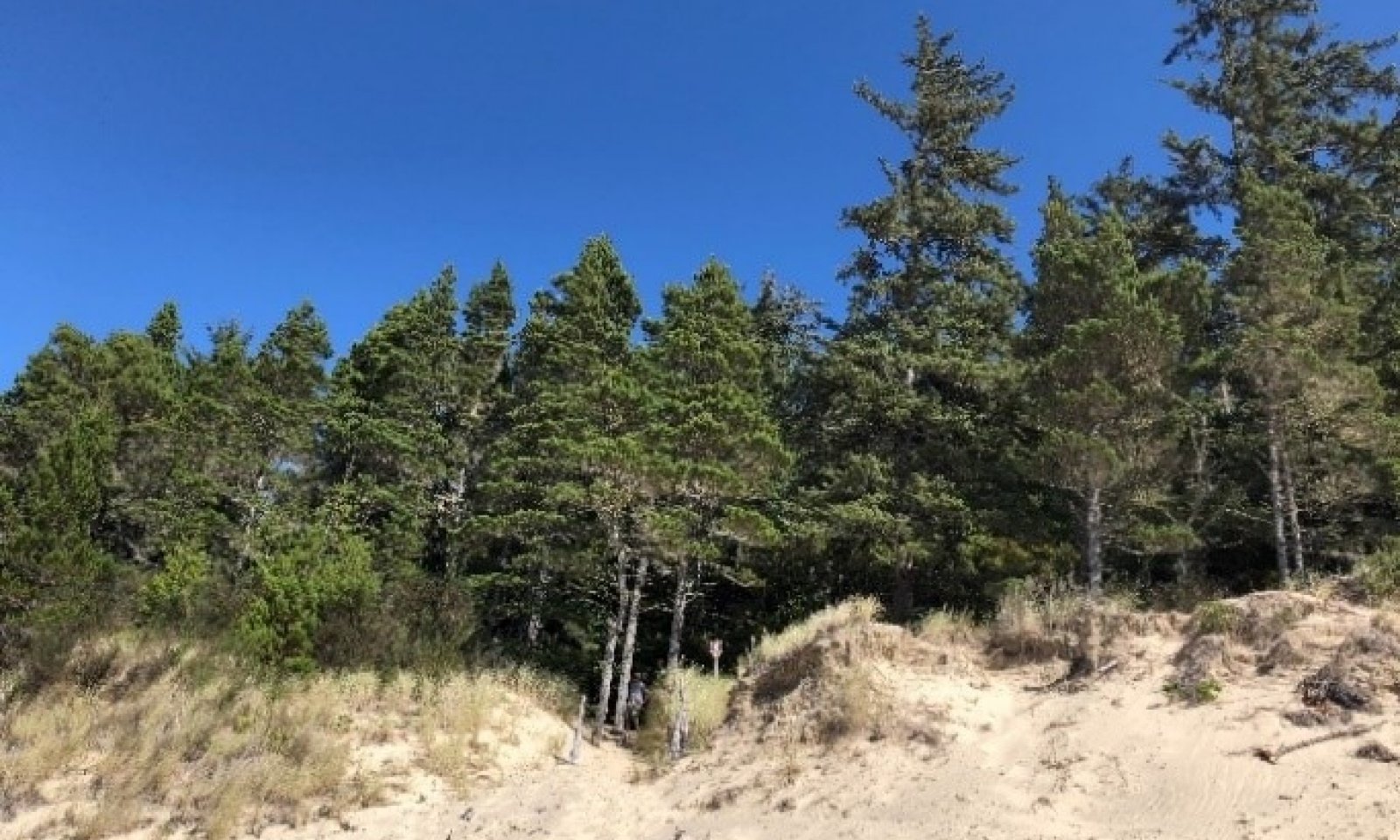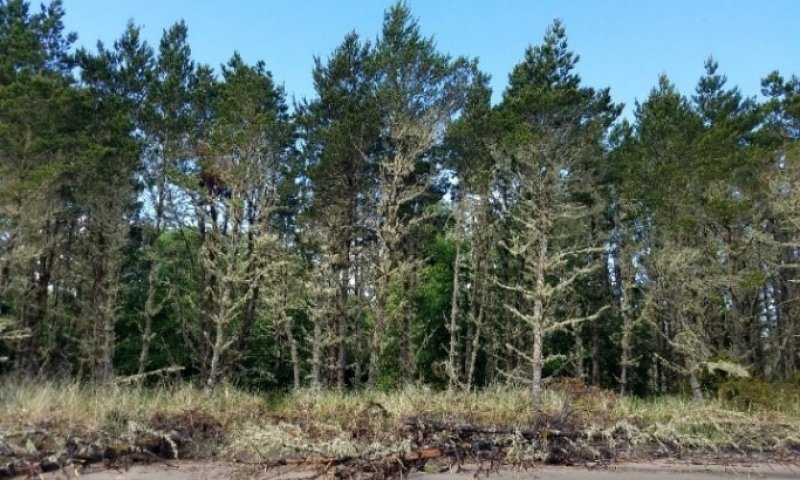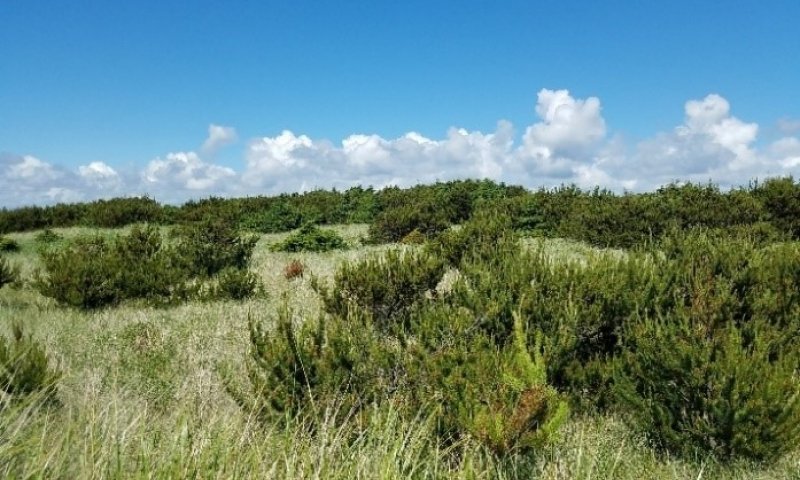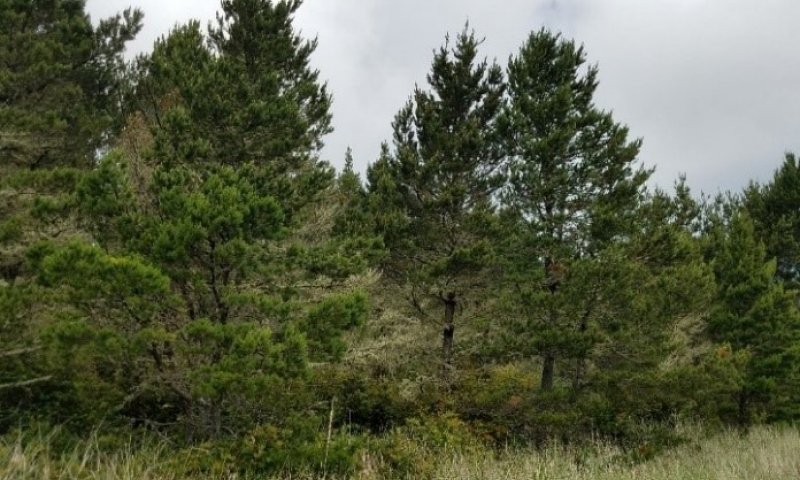

Natural Resources
Conservation Service
Ecological site F004AB202OR
Dune Forest
Last updated: 1/23/2025
Accessed: 12/20/2025
General information
Provisional. A provisional ecological site description has undergone quality control and quality assurance review. It contains a working state and transition model and enough information to identify the ecological site.
MLRA notes
Major Land Resource Area (MLRA): 004A–Sitka Spruce Belt
This resource area is along the coast of the Pacific Ocean. It is characterized by a marine climate and coastal fog belt. The parent material is primarily glacial, marine, or alluvial sediment and some scattered areas of Tertiary sedimentary rock and organic deposits. Glacial deposits are dominant in the northern part of the MLRA in Washington; marine and alluvial deposits and eolian sand are dominant along the southern part of the Washington coast and extending into Oregon. The mean annual precipitation ranges from 52 to 60 inches near the beaches to more than 190 inches in the inland areas of the MLRA.
Andisols and Inceptisols are the dominant soil orders in the MLRA, but Spodosols, Entisols, and Histosols are also present. The soils are shallow to very deep and very poorly drained to somewhat excessively drained. They are on hilly marine terraces and drift plains; coastal uplands, hills, and foothills; flood plains; and coastal dunes, marshes, and estuaries.
The soil temperature regimes of MLRA 4A are moderated by the proximity to the Pacific Ocean, which eases the differences between the mean summer and winter temperatures. The seasonal differences in temperature are more pronounced in adjacent MLRAs further inland. Included in MLRA 4A are soils in cooler areas at higher elevations or on northerly aspects that have an isofrigid temperature regime.
The soil moisture regimes of MLRA 4A are typified by soils that do not have an extended dry period during normal years. Many of the soils further inland in MLRA 2 have a dry period in summer. Soils in low-lying areas and depressions of MLRA 4A are saturated in the rooting zone for extended periods due to a high water table or long or very long periods of flooding or ponding.
MLRA 4A Soil Temperature Regimes
Isomesic The mean annual soil temperature (measured at a depth of 20 inches) is 46 to 59 degrees F, and the difference between the mean winter and summer temperatures is less than 11 degrees. The seasonal soil temperatures and difference between the mean winter and summer temperatures are moderated by the proximity to the ocean and the effects of fog in summer.
Isofrigid The mean annual soil temperature (measured at a depth of 20 inches) is 32 degrees F to less than 46 degrees, and the difference between the mean winter and mean summer temperatures is less than 11 degrees. The seasonal soil temperatures and difference between the mean winter and summer temperatures are moderated by the proximity to the ocean and the effects of fog in summer. The temperatures are cooler than in surrounding lowlands because of the higher elevation and differences in slope and aspect.
MLRA 4A Soil Moisture Regimes
Udic The soil rooting zone is not dry in any part for more than 90 cumulative days in normal years. Soil moisture does not limit plant growth because of the fog in summer.
Aquic The soil is virtually free of dissolved oxygen due to saturation of the rooting zone. The soils are saturated for extended periods during the growing season and may be subject to long or very long periods of ponding and flooding.
Refer to Keys to Soil Taxonomy for complete definitions of the soil temperature and moisture regimes.
LRU notes
The Central Sitka Spruce Belt land resource unit (LRU B) of MLRA 4A is along the west coast of Washington and Oregon. The LRU extends from the Chehalis River in Washington to South Slough in Oregon, and it is bounded on the west by the Pacific Ocean. This area consists of sand dunes, flood plains, and marine terraces that extend a few miles east and are parallel to the Pacific Ocean, and it transitions to steeper and higher elevation ridges and mountainsides of the western slopes of the Coast Range in Oregon. Near the shore in coastal lowland areas, the parent material is dominantly eolian (wind-deposited) sand, alluvium, and marine sediment. Residuum, colluvium, and landslide deposits derived from sedimentary and basaltic sources are on the coastal foothills and mountains, and minor additions of recent alluvium are along the river valleys. Several major rivers carved steep, narrow valleys through the coastal mountains and foothills before entering broader coastal valleys. Subduction zones along the Pacific Coast may cause significant earthquakes and tsunamis, which would disrupt the ecological processes beyond what is described in this ecological site description.
Classification relationships
National vegetation classification: G205 Vancouverian Dry Coastal and Lowland Beach Pine Forest and Woodland-Sand Dune Woodland Alliance; G751 North Pacific Western Hemlock-Sitka Spruce-Western Redcedar Seasonal Rainforest Group-Stabilized Dune Forest Alliance
Ecological Systems of Washington State community type: North Pacific Maritime Coastal Sand Dune and Strand
Plant associations of the Oregon Dunes National Recreation Area: Shore Pine-Sitka Spruce/Evergreen Huckleberry Forest; Sitka Spruce/Evergreen Huckleberry Forest
Ecological site concept
This ecological site is on the western coastline of the Pacific Northwest, from southern Washington through central Oregon. It is inland from the coastal beaches and foredunes. Forests develop on mature, stabilized dunes in areas where tree species are able to root and become established. The soils that support this site formed in eolian sand or mixed alluvium. They generally are weakly developed and have limited available water capacity due to the sandy texture.
The maritime climate is characterized by cool, moist summers and cool, wet winters. The mean annual precipitation is 60 to 110 inches. Coastal fog provides supplemental moisture in summer. Snowfall is rare, and it is not persistent when it occurs. The mean annual air temperature is 48 to 52 degrees F.
The dominant vegetation is tolerant of heavy winds, a high seasonal water table, wind desiccation, low nutrient availability, and salt spray. The most common species include Sitka spruce (Picea sitchensis), shore pine (Pinus contorta var. contorta), evergreen huckleberry (Vaccinium ovatum), salal (Gaultheria shallon), kinnikinnick (Arctostaphylos uva-ursi), California wax myrtle (Morella californica), Pacific rhododendron (Rhododendron macrophyllum), brackenfern (Pteridium aquilinum), false lily of the valley (Maianthemum dilatatum), and western swordfern (Polystichum munitum).
The most common natural disturbance is strong windstorms. Infrequent wildfires and storm tidal surges may occur.
Table 1. Dominant plant species
| Tree |
(1) Picea sitchensis |
|---|---|
| Shrub |
(1) Gaultheria shallon |
| Herbaceous |
(1) Pteridium aquilinum |
Click on box and path labels to scroll to the respective text.




